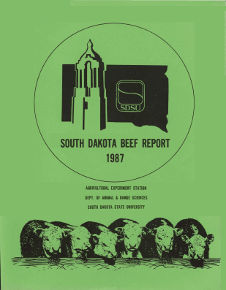Document Type
Report
Report Number
87-11
Publication Date
1987
Keywords
steer calves, growing systems, high grain, carcass
Summary
Crossbred steer calves (384 head) were used in a 2-year study to determine the effects of feedlot arrival weight and diet concentrate levels on feedlot performance and carcass variables. Steers were separated into Light (434 lb), medium (486 lb) and heavy (533 lb) groups based upon weights when they arrived at the feedlot. A low energy (LE) corn silage receiving and growing system was compared with a high energy (HE) system that involved feeding relatively higher levels of grain during receiving and growing periods. Calves were fed to similar fatness endpoints. Rate of gain was similar for weight groups, but lighter calves required more days on feed and were more efficient. Lighter calves also gained mare weight in the feedlot when slaughtered at a constant fat endpoint and weighed less than heavier arrival weight groups. High grain feeding during receiving and growing periods improved over all daily gains and feed efficiency but caused steers to reach the common fat endpoint at lighter weights. There were no interactions between arrival weight groups and feeding system. Nonfeed costs per unit slaughter weight were similar for each feeding system, indicating feed resources and feedlot turnover rate should be primary factors used in deciding which feeding system to employ.
Number of Pages
4
Type
text
Format
application/pdf
Language
en
Publisher
South Dakota State University
Rights
Copyright © 1987 South Dakota State University
Recommended Citation
Pritchard, R.H., "Feeding High Grain Diets to Steer Calves with Different Feedlot Arrival Weights" (1987). South Dakota Beef Report, 1987. 12.
https://openprairie.sdstate.edu/sd_beefreport_1987/12

